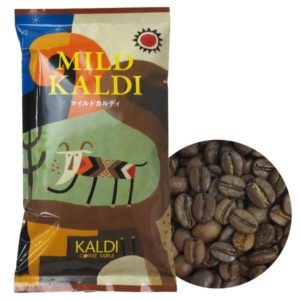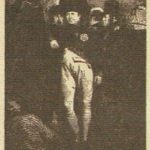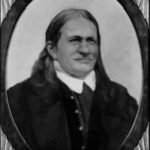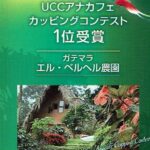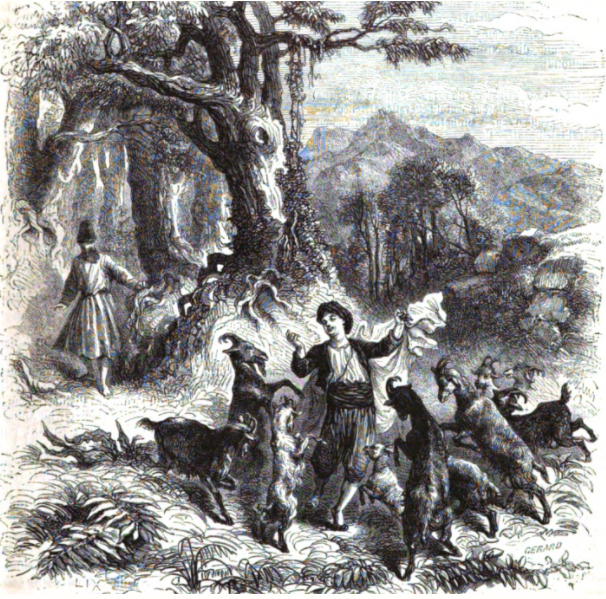
山羊飼いカルディの伝説とその変遷 ファウスト・ナイロニの説話はいかにして山羊飼いカルディの伝説へと姿を変えたのか
コーヒーの起源
コーヒーの使用がいつどのようにして始まったかは定かではない。9世紀にはすでに使用されていたという説がある一方、一部では西暦575年頃に栽培されていたという主張もある。
または、エチオピアのオロモ族(ガラ族)が使用していたエナジーボールがコーヒーの起源という説もある。あるいは、イスラムの奴隷貿易によってアラビア半島へと送られたスーダンの奴隷が、コーヒーの果実を噛むことで厳しい旅次を耐え忍び、彼らがコーヒーをアラビア半島に持ち込んだという話もある(出典不明)。
ともかく確からしいことは、コーヒーはエチオピアからアラビア半島に伝わり、そこで飲用の文化が始まったということだけである。
山羊飼いカルディの伝説
コーヒーの起源について最もポピュラーで有名な伝説は、ウィリアム・H・ユーカース(William H. Ukers, 1873 - 1945)の1922年著書(1935年に改訂)『オール・アバウト・コーヒー(ALL ABOUT COFFEE) 』で報告した「山羊飼いカルディ(Kaldi または Khalid)の伝説」である。
もう一つのもっともポピュラーな伝説によれば、この飲料を発見したのは、上エジプト(南エジプトのナイル川流域)、あるいはアビシニアのアラビア人山羊(やぎ)飼である、と伝えられている。この山羊飼が近くにある修道院の院長に愚痴をこぼした。山羊飼は、世話を任せられている山羊が、牧草地付近の灌木の実を食べると、いつになく浮かれて騒ぎ回るという。
その修道院長はその事実を確かめ、自分でも木の実の効力を試してみることにした。食べてみると、頭がはっきりして気分が浮き立ってくる。そこで彼は木の実を煮て、その煮出し汁を飲むようにと修道士たちに申し渡した。おかげで、その後修道僧たちは、居眠りもせずに夜の礼拝を続けられるようになったという。この「眠らぬ修道院」の噂が広まり、その不思議な木の実は「すぐさま王国中でもてはやされ、そして時を経るうちに他の国々、さらに東方の地でも飲まれる」ようになったと伝えられる。
ウィリアム・H・ユーカーズ(2017)『ALL ABOUT COFFEE コーヒーのすべて』,山内 秀文訳・解説,角川ソフィア文庫.p.37-38
『オール・アバウト・コーヒー』では、これに続く文章で、フランスに伝わっている山羊飼いカルディの伝説のヴァージョンが紹介されるが、山羊飼いカルディの伝説がコーヒーの起源の物語として定着したのは、ユーカースの『オール・アバウト・コーヒー』によるところが大きい。
この伝説には様々なヴァリエーションがあるが、現在伝わっている話を整理すると以下のようにまとめられる。
- 木の実(コーヒー)を発見したのは山羊飼い、あるいは山羊飼いが世話をしていたヤギである。
- 木の実を食べたヤギ、あるいは山羊飼いは、元気になり踊り回った。
- 山羊飼いの名前はカルディである。
- カルディは、西暦850年頃アビシニア(エチオピア)に住んでいた。
- カルディは修道院長にコーヒーを紹介した。
- 修道士(または修道僧)たちが木の実の煮出し汁を飲むと、頭がすっきりし、夜通し夜の礼拝を続けられるようになった。
この山羊飼いカルディの伝説は、アントニウス・ファウスト・ナイロニ(Faustus Nairon または Fauste Nairon de Baneまたは Antonius Faustus Naironus または Faustus Naironus Banesius)が、1671年の論説『カウエまたはカフェと呼ばれる健全な水薬についての論説(De Saluberrima potione Cahue seu Cafe nuncupata Discurscus)』で紹介した説話が元となっている。この論説は、1710年に『コーヒー論:その説明と美徳(A Discourse on Coffee: Its Description and Vertues)』として英訳されている。
それでは、この伝説はどこからくるのか。「カルディの伝説」がはじめて西洋世界に伝えたのは、東方を広く旅して回ったとされる Faustus Naironus Banesius という 17 世紀のマロン派キリスト教徒であり、ラテン語で「コーヒーについての言説(De Saluberrima potione Cahue seu Café nuncupata Discurscus)」(1671)という論説を著わしている。だがこの論説には、「カルディ」という固有名詞は登場せず、しかもエチオピアという地名も出て来ない。
石原 美奈子(2013)「コーヒーの意味と価値の変容 ――エチオピア南西部の事例――」,人類学研究所研究論集 ,南山大学人類学研究所,第1号.p.169
ファウスト・ナイロニは、ローマ出身のマロン派キリスト教徒であり、1635年に生まれ1707年頃亡くなったという情報もあれば、1628年に生まれ1711年頃亡くなったという情報もある。
ファウスト・ナイロニが紹介した山羊飼いカルディの伝説のオリジナルは、以下のように整理できる。
- ラクダ、またはヤギの世話をする人物が、彼の家畜の一晩中跳ね回り踊っていることを修道院の宗教者たちに不満を述べた
- 場所はアヤマン王国(幸福のアラビア)
- 修道院長が修道士の一人と一緒に、夜にラクダ、またはヤギを見張っていると、果実または、彼らが噛んだ果肉のある低木または茂みを見つかった。
- 彼らは水を沸騰させ飲んでみると、夜通し目覚め続け、夜の義務を務めることができることを発見した。
- この飲み物は王国全体や他の国々や地方、そして東方にまで広がった。
ナイロヌスが伝えたこの伝説に出てくる「ラクダもしくはヤギの世話をする者」が、どのようにして「ヤギ飼いカルディ」に、そして「アヤマン王国」すなわちイエメンが、どのようにして「エチオピア」にすり替わったのかは謎である。それはともあれ、「カルディの伝説」の疑わしさについては、「ナイロン(ナイロヌス)のカフェインに刺激された文学的想像」によるもので「初期のヨーロッパ人のコーヒー飲みに受け入れられて広まった」にちがいないと指摘されている(Weinberg & Bealer 2001: 4)。
石原 美奈子(2013)「コーヒーの意味と価値の変容 ――エチオピア南西部の事例――」,人類学研究所研究論集 ,南山大学人類学研究所,第1号.p.170
山羊飼いカルディの伝説が史実かどうかを問えば、一笑に付して終わりだろう。しかし山羊飼いカルディの伝説がコーヒーの起源の物語として人々に受容されていったことは、意味のないことではない。人間の認識において、起源は神話として表現される。それは同定不可能な想像の産物だ。しかし、人間は我ら共通の物語である歴史を可能にするために神話を捏造するのである。
ここでは「ラクダ、またはヤギの世話をする人物」が山羊飼いカルディに、アヤマン王国(幸福のアラビア)がエチオピアに、いつどのようにして変遷したのか。また、単なる説話の一つに過ぎなかったものが、いかにして伝説として定着したのかを見ていきたい。
イギリスにおける受容
トーマス・ポープ・ブラント卿(Sir Thomas Pope Blount)『博物学(A Natural History)』
コーヒー、またはカヴフェに関する所見(Observations concerning COFFEE, or CAVPHE)
ファウスト・ナイロニの『カウエまたはカフェと呼ばれる健全な水薬についての論説』が発表された22年後の1693年に、イギリスの政治家であるトーマス・ポープ・ブラント卿(Sir Thomas Pope Blount, 1649 - 1697)が発表した『博物学、現代最高の著者から抜粋した多くの一般的ではない観察を含む(A Natural History, containing many not common observations extracted out of the best modern writers)』の「コーヒー、またはカヴフェに関する所見(Observations concerning COFFEE, or CAVPHE)」の章では、ファウスト・ナイロニの説話が紹介されている。
There goes a Story, ( how true I know not ) that the Vertue of COFFEE , was at first discover'd by a Prior of a Convent ; who observing that the Goats , which fed in that part of Arabia where these Trees grow , us'd to live with little or no Sleep, and that in the day time they were mighty brisk and frisking ; the faid Prior did from thence conclude, that this must necessarily proceed from the Goats licking up the Berries that fell form these Trees : Whereupon to satisfy his Curiosity, He try'd the Experiment upon another sort of Beast, viz. a Sleepy Heavy-Headed Monk, whom the Prior did often ply with this sort of Drink; on whom, as the Story goes, it had, in a short time, such a wonderful effect, that it quite alter'd his Constitution, and that he afterwards became more quick, brisk, and airy, than generally that sort of Cattle are.
Sir Thomas Pope Blount(1693)"A Natural History, containing many not common observations extracted out of the best modern writers"p.114
ここで伝えられる物語の特徴を列記すると、以下のようになる。
- コーヒーの美徳(the Vertue of COFFEE)は、修道院院長(Prior of a Convent)によって発見された。
- 場所はコーヒーノキが成長するアラビア。
- ヤギは登場するがヤギの世話をする者(山羊飼い)は登場しない。
- 修道院院長は、眠気で頭の重い修道士でこの飲料を試してみると、牛よりも頭がより早く、活発に、すっきりした。
- しかしこの話がどの程度正しいかは知らない、という但し書き。
- 引用元は記載されていない。
コーヒーの美徳(the Vertue of COFFEE)
「コーヒーの美徳(the Vertue of COFFEE)」というブラント卿の記述は、ファウスト・ナイロニの『コーヒー論』の1710年の英訳の副題『その説明と美徳(Its Description and Vertues)』、あるいは本文中に「これらの果実の美徳(the Vertues of these Berries)」という表現として登場する。しかし、1693年時点でこの英訳は存在しない。
この「美徳、徳(Vertue)」は、1663年の著者不明『コーヒーの美徳(The Vertues of Coffee)』、1670年のロバート・モートン(Robert Morton)『コーヒーの性質、品質、そして最も優れた美徳(The nature, quality, and most excellent vertues of coffee)』、1690年のサミュエル・プライス(Samuel Price)『コーヒー、チョコレート、そして茶の美徳(The Virtues of Coffee, Chocolette, and Thee or Tea)』、1721年のリチャード・ブラッドリー(Richard Bradley)『ペストや他の感染性に関するコーヒーの美徳と使用(The Virtue and Use of Coffee With Regard to the Plague and Other Infectious)』など、この時代のコーヒー本や広告のタイトル、あるいは本文によく見られる表現である。
Thomas Ladendorf “Excellent Vertues” and Virtuosic Speculations: Medical and Historical Knowledge about Coffee in England, 1650-173:https://core.ac.uk/reader/213851820
ちなみに、王立協会フェローであるリチャード・ブラッドリーの『ペストや他の感染性に関するコーヒーの美徳と使用』では、1710年に英訳された『コーヒー論:その説明と美徳(A Discourse on Coffee: Its Description and Vertues)』の説話の部分がそのまま引用された後(19から20ページ)、この説話がファウスト・ナイロニが教師をしていたイタリアで一般的に受け入れられた可能性が高いらしいことが述べられる。
THIS Story may very likely have given rise to that Opinion so generally receiv’d amongst the Italians, That the Use of Coffee was first discover’d and brought out of Asia into Europe by some Fryers.
Richard Bradley(1721)"The Virtue and Use of Coffee With Regard to the Plague and Other Infectious"p.20
スルタン・マホメット・キャスウィン(Sultan Mahomet Caswin)
ブラント卿の『博物学』では、ファウスト・ナイロニの説話の紹介の直前に、ティムール以前にペルシャに君臨した王の一人であるスルタン・マホメット・キャスウィン(Sultan Mahomet Caswin)のエピソードが紹介されている。
このエピソードは、アダム・オレアリウス(Adam Olearius, 1603 - 1671)が、1637年の旅行記で報告するエピソードである。
続いてこれも五四ページで紹介したドイツのオリエント学者、アダム・オレアリウス(エルシュラゲール)は、一六三三〜三六年にかけてドイツ大使の事務官としてペルシャを旅行し、帰国後の一六三七年にその旅行記を刊行している。その中でペルシャ人について次のように記している。
「彼らは煙草を吸いながら黒い水を飲んでいる。それはカーワ cahwa とよばれ、エジプトからもたらされる果実から作る。色は一般的な小麦に似ていて、トルコの小麦のような味がする。大きさは小さな豆ほどである」。
ウィリアム・H・ユーカーズ(2017)『ALL ABOUT COFFEE コーヒーのすべて』,山内 秀文訳・解説,角川ソフィア文庫.p.95-96
1637年のアダム・オレアリウスの旅行記は、1662年に『フレデリク・ホルシュタイン公がモスクワ大公国とペルシャ王に送った大使たちの航海と旅(The voyages and travells of the ambassadors sent by Frederick, Duke of Holstein, to the Great Duke of Muscovy and the King of Persia begun in the year M.DC.XXXIII. and finish'd in M.DC.XXXIX)』として英訳されている。ユーカースが引用した部分とその続きは、以下のとおりである。
They drink with their tobacco a certain black water which they call cahwa, made of a fruit brought out of Egypt and which is in color like ordinary wheat, and in taste like Turkish wheat, and is of the bigness of a little bean. They fry or rather burn it in an iron pan without any liquor, beat it to powder, and boiling with fair water, they make this drink thereof which hath as it were the taste of a burnt crust and is not pleasant to the palate. It hath a cooling quality and the Persians think it allays the natural heat. Whence it comes that they often drink of it inasmuch as they would avoid the charge of having many children, nay they are so far from dissembling the fear they have thereof that some of them have come to our physician for remedies of that kind. But he being a merry disposed person made answer that he would rather help them to get children than give them ought to prevent the getting of them. I say the Persians are persuaded this water is able absolutely to smother all natural heat and to take away the power of engendering;
Adam Olearius(1662)"The voyages & travels of the ambassadors sent by Frederick Duke of Holstein, to the Great Duke of Muscovy, and the King of Persia, begun in the year M. DC. XXXIII. and finish'd in M. DC. XXXIX."p.322
コーヒーがヨーロッパに伝わってまもない頃は、コーヒーはエジプトからもたらされるという記述が一般的であった。この時代のヨーロッパにおいて、アラビカ種コーヒーがエチオピア発祥であるとは知られていなかった。やがてアラビカ種コーヒーの発祥がエチオピアであると知られるにつれ、エチオピアのコーヒーの起源の物語が必要とされたのではないだろうか。
コーヒーは「冷」の性質を持っているため、ペルシャ人はそれは熱の性質(性欲)を減衰させると考え、子供が多すぎるという非難を避けることができるという説明の後、スルタン・マホメット・キャスウィンのエピソードがこの例として続く。
and to this purpose they tell a story of one of their Kings, named Sultan Mahomet Caswin, who Reign’d in Persia before Tamerlane's time, that he was so accustom’d to the Drinking of Cahwa , that he had an inconceivable aversion on for Women ; and that the Queen standing one day at her Chamber Window, and perceiving they had got down a Horse upon the ground, in order to the Gelding of him, ask’d some that stood by, why they treated so handsome a Creature in that manner; whereupon answer being made her, that he was too Fiery and Metalsome, and that the business of those that were about him, was, with the taking away of the excess of Metal, which Stone-Horses are guilty of , to deprive him of all generative Vertue; the Queen reply’d , that that trouble might have been spar’d , since the Cahwa would have wrought the same effect; and that if they would keep the Stone-Horse with that Drink, he would, in a short time, be as cold as the King her Husband.
Adam Olearius(1662)"The voyages & travels of the ambassadors sent by Frederick Duke of Holstein, to the Great Duke of Muscovy, and the King of Persia, begun in the year M. DC. XXXIII. and finish'd in M. DC. XXXIX."p.323
ブラント卿のスルタン・マホメット・キャスウィンに関する記述は、このオレアリウスの記述の引用である。
To this purpose they tell a story of one of their Kings, named Sultan Mahomet Caswin, who Reign’d in Persia before Tamerlane's time, that he was so accustom’d to the Drinking of COFFEE , that he had a strange aversion to all Women ; and that the Queen standing one day at her Chamber Window, and perceiving they had got down a Horse upon the ground, in order to the Gelding of him, ask’d some that stood by, why they treated so handsome a Creature in that manner; whereupon answer being made her, that he was too Fiery and Mettlesome, and that the business of those that were about him, was, with the taking away of the Excess of Mettle, which Stone-Horses are guilty of , to deprive him of all Generative Vertue; the Queen reply’d , that that trouble might have been spar’d , since the COFFEE would have wrought the same effect; and that if they would keep the Stone-Horse with that Drink, he would, in a short time, be as cold as the King her Husband. OLEARIUS in the Ambassadors Travels, pag.240
Sir Thomas Pope Blount(1693)"A Natural History, containing many not common observations extracted out of the best modern writers"p.113-114
CahwaとCahwaがCOFFEEに、an inconceivable aversion on for Womenがa strange aversion to all Womenに、MetalsomeがMettlesomeに、the excess of Metalがthe Excess of Mettleに、generative VertueがGenerative Vertueに置き換わっているが、文章の構造は同じであり、最後に引用元としてオレアリウスの著書が記載されている。
ちなみにこのエピソードは、ジョン・チェンバレン(John Chamberlayne, c.1668–1723)の1682年の著書『コーヒー、茶、チョコレート、タバコの自然史(The Natural History of Coffee, Thee, Chocolate, Tobacco)』にも取り上げられている。
This most famous Olearius ( that made fo many curious, and accurate Observations in his Travels) tells us of a Persian King, named Sultan Mahomet Caswin, who Reigned in Persia before Tamerlane's time, that was so accustomed to drinking of Cahwa, or Coffee, that he had an unconceivable aversion to Women, and that the Queen standing one day at her Chamber Window, and perceiving they were about gelding a Horse, ask'd some standers by, why they treated to handsom a Creature in that manner; whereupon answer was made her, that he was too fiery and mettlesome, therefore they resolv'd to deprive him of his generative faculty : the Queen reply'd, that trouble might have been spar'd, since Cahwa, or Coffee, would have wrought the same effect, the experiment being already try'd upon the King her Husband.
John Chamberlayne(1682)"The Natural history of coffee, thee, chocolate, tobacco"p.5
ブラント卿のスルタン・マホメット・キャスウィンのエピソードは、オレアリウスの著書を引用・参照している。しかし、ファウスト・ナイロニの伝える話の内容とトーマス・ポープの記述の相違、但し書き、そして引用元の記載がないことを見ると、ブラント卿が実際にファウスト・ナイロニの『カウエまたはカフェと呼ばれる健全な水薬についての言説』のラテン語原典(英訳はこの時点で存在しない)を参照したと考えることはできない。おそらくこのような話があると伝え聞いただけだろう。
不確かなヤギ
ファウスト・ナイロニが紹介した説話を、ブラント卿がどのようにして知ったのかは定かではない。しかし、ブラント卿は1690年の著書"Censura celebrorum authorum sive tractatus in quo varia virorum doctorum de clarissimis cujusque seculi scriptoribus judicia traduntur"を書くなかで、ファウスト・ナイロニを知った可能性はある。非常な労力を費やして書かれたこの本は、元々ブラント卿自身が使用するために編集されたもので、さまざまな著名な作家が互いについて語ったことを年代順にまとめた辞書である。
ブラント卿の『博物学』は、植物、宝石、昆虫、自然など50にわたる分野を扱う百科事典的な集成であるが、ここにおいてすでに、ファウスト・ナイロニの説話の伝承は不確かなものだった。「ラクダ、もしくはヤギの世話をする者」がヤギのみが記述されるようになったのは、すでにこの時点から始まっていたのである。
ジェームス・ダグラス(James Douglas)『コーヒーノキの説明の補足(A supplement to the description of the coffee-tree)』
コーヒーの起源の検討
スコットランドの医師であるジェームス・ダグラス(James Douglas,1675 -1742)は、1727年の著作『コーヒーノキの説明の補足(A supplement to the description of the coffee-tree)』において、コーヒーの飲用の起源に関する様々な説に詳細な検証をしている。彼はコーヒー関連では、1725年に"Lilium Sarniense: or, A Description of the Guernsay-Lilly; to which is added the botanical dissection of the coffee-berry"、1727年に"Arbor Yemensis fructum cofè ferens : or, A description and history of the coffee tree" という著作も発表している。
ダグラスの『コーヒーノキの説明の補足』では、当時としては珍しく、コーヒーの起源に関する様々な歴史的記述が実証主義的に検討されている。彼はホメロスのネペンテスが実はコーヒーだったのではないかといった、コーヒーの起源を古代に遡る説を退けた後、次のように述べる。
All these Conjetures about Coffee relate to the time in which the Authors of them suppose that it was already known in the World, but they are intirely silent about the Means by which it was first discover’d. Concerning this I find nothing said by any Author before Banefus. But as he has neither mention’d the Time, nor the Authority on which his Story is built, it may justly be call’d the second Part of the fabulous History of Coffee.
James Douglas(1727)"A supplement to the description of the coffee-tree"p.4
彼によれば、コーヒーの発見について初めて触れた人物はファウスト・ナイロニである。そして、トーマス・ポープ・ブラント卿が『博物誌』で紹介したファウスト・ナイロニの説話について以下のように紹介する。
This Story carries in every Particular of it too great an Air of Fable to be in the least depended on ; and they who are acquainted with the Nature of Vulgar Traditions, especially those of the Eastern Nations, will easily imagine that it can receive but a very small degree of Credibility from thence, let them be never so common or universal; which is more than can be said of this, since no Writer, that I can find, has mentioned it, except Banesius, and those that copy’d it from him.
Among the rest, Sir Thomas Pope Blount has vary’d some part of Banesius's Story in a very diverting manner, which I cannot help setting down : 'The Prior, says he, believing from what he had seen of the Goats, that this must proceed from their licking up the Berries that fell from these Trees, to satisfy his Curiosity further, try’d the Experiment upon another sort of Beast, a sleepy heavy-headed Monk, whom he often ply’d with this sort of Liquor ; and in a short time, as the Story goes, it had such a wonderful Effect upon him, that it quite alter’d his Constitution, and he afterwards became more quick, brisk, and airy than generally that sort of Cattle are.’
James Douglas(1727)"A supplement to the description of the coffee-tree"p.6
ダグラスによれば、ファウスト・ナイロニの説話は寓話に依りすぎ、東方の国々の俗語の伝統に通じていれば、ほとんど信用するに値しない。そして、彼が知り得る中でこの寓話に言及したのはファウスト・ナイロニとそれを写したもののみである。
I cannot conceive how M. du Four, who was certainly a Man of good Judgment, should give into so groundless a Fiction in so serious a manner. He not only adopts Banesius's Story without reserve, but is at pains to introduce it by a very formal Preamble, as follows.
James Douglas(1727)"A supplement to the description of the coffee-tree"p.6
ダグラスは、ファウスト・ナイロニの説話を紹介したフィリップ・シルヴェストル・デュフール(Philippe Sylvestre Dufour, 1622 - 1687)の前置きを英訳で引用する。
'There is no room to doubt, but that when God at the beginning of all things commanded the Earth to bring forth Herbs and Trees, he at the same time communicated to them the Qualities he thought fit to give them. And therefore we must not doubt but that Coffee, from its first Origin, had all these Properties for which we esteem it at this day. But it does not follow from thence, that they have been always known. Many Ages pass’d, during which Men were altogether Strangers to them, and did not so much as know what Coffee was. However, as God had communicated to it its natural Virtues for the Good of Man, he did not suffer them to remain for ever without its Assistance : He was pleas’d at length to rescue this Treasure from Obscurity and Darkness, and to display its Virtues to the World. The Means he made use of for this are so surprizing, that I am persuaded the Recital of them will appear no less wonderful than entertaining.'
James Douglas(1727)"A supplement to the description of the coffee-tree"p.6-7
この英訳のフランス語原文は、フィリップ・シルヴェストル・デュフールの1685年の著書『コーヒー、茶、チョコレートに関する新たな興味あふれる概論(Traitez nouveaux & curieux du café, du thé et du chocolate)』の第五章に現れる。この本は『オール・アバウト・コーヒー』で頻繁に参照・引用される本である(山内 秀文訳『ALL ABOUT COFFEE コーヒーのすべて』の351ページ参照)。この前置きの原文は以下のとおりである。
IL n'y a pas lieu de douter que lors que Dieu au commencement de toutes choses commanda à la terre de produire des herbes , & des arbres , il ne leur communiquât les qualités qu’il vouloir leur donner. Sur ce principe il est confiant que le Café dez son origine a eu celles qui font qu’aujourd’huy nous l’estimons , & que nous le recherchons. Il ne faut pas croire pourtant que de tout tems elles ayent été connuës: il s’est passé bien des Siècles , que non seulement on les a ignorées , mais que même on n’a pas sçu ce que c'étoit que Café. Dieu toutesfois qui par sa puissance luy avoit communiqué les propriétés qui luy font naturelles pour l'avantage de l'homme , ne voulut pas permettre que son ignorance le privât pour toujoûrs du secours qu’il en pouvoit recevoir , & il voulut bien enfin par sa bonté qu’on tirât des tenebres ce tresor , dont l’utilité se répand sur tant de peuples. Les moyens dont il se servit pour cela sont si surprenans , que je suis persuadé qu’on les apprendra avec autant d admiration que de plaisir.
Philippe Sylvestre Dufour(1685)"Traitez nouveaux & curieux du café, du thé et du chocolate"p.33-34
アル・ラーズィー(al-Rāzī)のバンカ(Banca)とアヴィセンナ(Avicenna)のブンコ(Buncho)
ダグラスは、古代におけるコーヒーの使用はもとより、アル・ラーズィー(al-Rāzī)のバンカ(Banca)、アヴィセンナ(Avicenna)のブンコ(Buncho)などがコーヒーであったのではないかという説も退ける。
This long Detail will help us a little to clear up the History of two Simples in the antient Materia Medica, by ihewing wherein they differ from others which modern Writers had confounded with them. But my chief View in entering upon it was to prove, that the first Discovery of Coffee is later than the Time of Avicenna ; and in the next place to teach us what Judgment is to be made of a great many Virtues attributed to it by the Writers since Rauwolfus ; and that is, that in as far as these Virtues have been mention’d only on Avicenna's Authority, they are not to be allow’d of ; and that in order to this, we must have other Reasons than either Rhazes or Avicenna can furnish us with.
James Douglas(1727)"A supplement to the description of the coffee-tree"p.11
この説は多くの書物に掲載され、また現在でも生き延びている説である。
ラーゼス(アル・ラジー865~922)の記述したブンカBunca、アヴィケンナ(イブン・シーナー980~1037)のブンクムBunchumはコーヒーであるとの説(初期コーヒーを紹介したラウヴォルフやアルピーニの『エジプトの植物』中の記述=1591年刊。ブンクムは植物の根であると後に論駁される。この説をめぐって盛んに論争が行われ、多くの書物にその説が掲載されている)
山内 秀文「解析:「コーヒー発見」仮説と伝説(1)」カフェ・マニアックス
*あるいは、山内 秀文訳『ALL ABOUT COFFEE コーヒーのすべて』の27ページ参照。
ファウスト・ナイロニはコーヒーが発見された時期について何も語っていない。しかし、ファウスト・ナイロニはアヴィセンナから引用するほどコーヒーに精通しており、彼はアヴィセンナによってすでにコーヒーが知られていると考えているため、コーヒーの発見を11世紀中頃までにその時期を設定する必要があっただろう(ダグラスはアヴィセンナからの引用を2箇所見つけたと書いているが、ファウスト・ナイロニの『コーヒー論』には、それ以上に多くのアヴィセンナへの言及がある)。
After so grave an Introduction, one would have expected nothing less than an Account of some Miracle, or at least some very extraordinary Dispensation of Providence ; but, instead of that, we find only an idle Monkish Dream, or, which is most commonly the same thing, an Oriental Tradition.
I have already observ’d, that Banesius has said nothing about the time when this lucky Accident happen’d ; but since he is of opinion, that the Fruit of the Coffee-Plant was known to Avicenna, he must needs have placed it before the middle of the eleventh Century. I find two Passages quoted from Avicenna, from which it has been concluded, that he was acquainted with Coffee ; the first, as it stands in the Latin Translation, is in these Terms.
James Douglas(1727)"A supplement to the description of the coffee-tree"p.7
現在山羊飼いカルディの伝説が西暦850年頃に設定されているのは、アヴィセンナではなく、アル・ラーズィーの生年が混在したためではないだろうか。その意味では、ビンガムトン大学(Binghampton University)のヌキル・ヌゼグ(Nkiru Nzegwu)教授のこの「発見」は、遡行的に見出された歴史的誤謬として退けることができるだろう。
Arabic scientific documents dating from around AD 900 refer to a beverage drunk in Ethiopia, Known as ‘buna’, and the similarities in the words suggests that this could be one of the earliest references to Ethiopian, coffee in its brewed form.
Nkiru Nzegwu(1996)"Ethiopia the origin of Coffee",Selamta, The In-Flight Magazine of ETHIOPIAN AIRLINES. Volume 13, Number 2
フランスにおける受容
フィリップ・シルヴェストル・デュフール(Philippe Sylvestre Dufour)『コーヒー、茶、チョコレートに関する新たな興味あふれる概論(Traitez nouveaux & curieux du café, du thé et du chocolate)』
ファウスト・ナイロニの説話のフランスにおける最初の紹介
フィリップ・シルヴェストル・デュフール(Philippe Sylvestre Dufour, 1622 - 1687)は、1684年の著書『コーヒー、茶、チョコレートに関する新たな興味あふれる概論(Traitez nouveaux & curieux du café, du thé et du chocolate)』で、トーマス・ポープ・ブラント卿『博物学』よりも早く、ファウスト・ナイロニの説話を紹介した。彼がおそらくファウスト・ナイロニの説話をフランスに紹介した最初の人物である。
ファウスト・ナイロニの説話は、上記に引用した前書きの後に、次のように紹介される。
Un Gardien de Chameaux dit-il , selon le sentiment de quelques-uns , ou de Chevres suivant l’avis de quelques-autres , se plaignit, à des Moines que par fois ses chèvres ou ses chameaux Veilloient , & sautoient toute la nuit contre leur ordinaire : le Prieur se douta aussitôt que ce ne pouvoit être qu’un effet de leur pâturage. Pour s’en éclaircir , il se porta sur les lieux , & confiidera que celuy où ce bétail avoit passé le jour qui avoit précédé la nuit qu’il sautoit , étoit plein de certains arbrisseaux , dont ils mangeoient le fruit , il en emporta pour tacher d’en découvrir les qualités ; & en fit boüillir dans l’eau : après en avoir beu il s’apperçut quelle faisoit veiller , ce qui l’obligea d’en donner à ses Moines pour les empêcher de dormir dans le tem des Offices de Ia nuit. Les suites répondirent à son attente , & bien-tôt aprés a on découvrit que ce fruits avoit beaucoup d’autres proprietés sort salutaires , qui lu y acquirent sans peine une estime extraordinaire, & universelle ; mais principalement parmy ceux qui en vendent. Leur interest a fait naître leur reconnoissance , ils la croiroient imparfaite , s’ils ne faisoient des prières particuliere & ordinaires pour Sciadli & Aydrus , qui sont les Moines qu’on croit avoir fait la première découverte de ce fruit.
Philippe Sylvestre Dufour(1684)"Traitez nouveaux & curieux du café, du thé et du chocolate"p.34-35
ここでは、コーヒーに果実を最初に発見した修道士として、SciadliとAydrusという名前が挙げられている。
シアズリー(Sciadli)とシェイク・シャーズィリー(scheïkh Schadhéli)
SciadliとAydrusという人物の名前は、『カウエまたはカフェと呼ばれる健全な水薬についての論説』の18ページで、説話の紹介に続く文章で、コーヒーの飲用の最初の発明者として紹介される。
The Turks themselves are generally wont to own, that these Monk were the first Inventors of this Liquor, and had the first Hint of it from Goats or Camel : In a Sort of Thankfulness and Gratitude to these Monks, the Turks that fill you this Liquor are used to pray for them, having set and peculiar daily Oraisons for Sciadli and Aidrus , which they believe are the Names of the Monks before mention'd.
Antonius Faustus Naironus(1710)"A Discourse on Coffee: Its Description and Vertues"p.6
SciadliとAydrusという人物について、アントワーヌ=イザーク・シルヴェストル・ド・サシー(Antoine-Isaac Silvestre de Sacy, 1758 - 1838)がフランス語に抄訳したアブドゥル・カーディル・アル=ジャジーリー(Abd-alkader Ansari Djézéri Hanbali)の『コーヒーの合法性の擁護』の注釈(38)では、次のように解説されている。
(38) Fauste Nairon, qui attribue l'introduction de l'usage du café à deux moines chrétiens, dit qu'ils se nommoient Schadli et Aïder : Primos igitur hujus potionis inventores, . . ferunt extitisse monachos christianos, ut ipsimet Turcœ fateri ut plurimùm assolent , in quorum gratiam animique obsequium pro illis fundunt preces , ac prœsertim Turcœ illi qui sunt hujus potionis ministratores et distributores : proprias enimhi ac quotidianas habent preces pro Sciadli et Aïdrus , quia hœc supradictorum monachorum fuisse nomina asserunt ( De salubri potione cahve seu café nuncupatâ discursus ; Romœ, 1661 , pag. 8 ). Sciadli est "アラビア語" et Aïdrus est "アラビア語" Haïder , l'inventeur de l'usage de la feuille de chanvre "アラビア語". Voyez ci-devant, pag. 210. Il ne faut pas manquer de consulter ce que M. Niebuhr rapporte au sujet du scheïkh Schadhéli , dans son Voyage en Arabie , tom. I , pag. 349 et 350.
Antoine-Isaac Silvestre de Sacy(1826)"Chrestomathie arabe : ou, Extraits de divers écrivains arabes, tant en prose qu'en vers, avec une traduction française et des notes, à l'usage des élèves de l'École royale et spéciale des langues orientales vivantes"
(38)二人のキリスト教修道士にコーヒーの使用の紹介を帰した、ファウスト・ナイロニは、彼らがSchadliとAïderと名付けられたと述べている。(中略)M. ニーブールが彼のアラビアへの航海で、シェイク・シャーズィリー(scheïkh Schadhéli)について報告したことを確認するのを見逃してはならない。
このシェイク・シャーズィリー(scheïkh Schadhéli)は、『コーヒーの合法性の擁護』の注釈(96)で解説されており、「モカの守護聖人」と呼ばれる人物である。
そしてド・サシーは、カールステン・ニーブール(Carsten Niebuhr)の1776年の著書『アラビアおよび他の近隣諸国への旅(Voyage en Arabie et en d'autres pays circonvoisins)』の「サナアからモカへの旅(VOYAGE DE SANA'' à MOCHHA)」を参照するように指示する。
Comme j’étois à Mochha plus assidu à visiter les Anglois, que les Arabes, ainsi n’ai je pas fait des découvertes éxactes sur l’ancienneté de cette ville. Toujours est- il certain, que Mochha est une des villes nouvelles du Tehâma, & qu'elle n’a pas plus de 400 ans. On dit qu’environ dans ce temps-là vivoit un Solitaire fameux nommé Schech Schädeli , qui passe généralement pour fondateur de cette ville. Ce Schech s’acquit une si grande reputation par sa vie folitaire, & religieuse, qu’on venoit des pays éloignés, pour entendre ses instructions. On m’a raconté à son sujet l’anecdôte suivante: Un jour un vaisseau venu des Indes, & destiné pour Dsjidda, jetta l’ancre dans ce parage. Les gens de l’équipage ayant apperçu une petite cabane dans ce désert, la curiosité les engagea à aller à terre. Le Schech fît à ses hôtes l’accueil le le plus gracieux, & les régala de café, boisson, qu’il aimoit beaucoup, & à laquelle il attribuoit maintes excellentes vertus. Les Indiens, à qui l’usage du café étoit tout- à-fait nouveau, regardèrent cette liqueur chaude comme un remède. Ils s’imaginèrent, que peut-être pourroit-on s’en servir à guérir le marchand de leur vaisseau , qui justement se trouvoit malade, & le Schech Schädeli les assura, que par le secours de ses prières, & l’usage de cette boisson non seulement le malade seroit rétabli, mais qu’il lui procureroit encore un gain considérable, s’il vouloit débarquer ses marchandises. Il prophétisa en même temps, qu’un jour, à la même place, seroit bâtie une ville commerçante, & que les Indiens y viendraient dans la suite vendre une grande partie de leurs marchandises. Ce langage parut si singulier au marchand, que l’envie lui prît de se faire transporter à terre le jour suivant, afin de voir lui-même, & d’entretenir cet homme extraordinaire. II devoir venir ce jour-là même une grande quantité d’Arabes , pour visiter le Solitaire, & entendre sa prédication. Le Marchand âvala le café, que le Schech Schädeli lui avoit appreté, & se trouva mieux. Parmi les Arabes, qui étoient venus rendre visite au Schech, se trouvèrent plusieurs marchands; ils achéterent toute la cargaison. Le Marchand s’en retourna ainsi plein de satisfaction aux Indes ; & la grande sainteté du Schech se répandit de plus en plus parmi ses compatriotes. Autour de la petite cabane de Schädeli, on en bâti plusieurs autres. A mesure que le nombre des marchands s’y rendoient par terre en plus grand nombre, il y venoit aussi mouiller plus de vaisseaux. C’est ainsi qu'il s’y forma d’abord un village, & par après la ville commerçante de Mochha prit son origine. Sur le tombeau du Schech Schädeli, qui est encore actuellement hors de la ville, est bâtie une grosse mosquée, qui porte son nom. Le puît, qui fournit de l’eau aux gens du commun de Mochha, n’ayant pas d’argent pour en acheter de la meilleure, s’appelle Schädeli. Il y a encore une des portes de la ville qui se nomme ainsi. Ses descendais sont encore honorés actuellement à sa considération, & décorés du titre de Schechs. C’est par lui, que le peuple de Mochha jure ordinairement : En un mot le nom de Schädeli ne sera jamais oublié tant que Mochha subsistera. Un marchand de la Mécque, avec qui j’avois beaucoup conversé à Bombay, fit sur ces sortes de saints une rémarque, à laquelle je ne me derois pas attendu de la part d’un mahométan. Il faut toujours à la populace, dit-il, un objet sensible, qu’elle honore, & qui la tienne en crainte. C’est ainsi, qu’à la Mecque & à Médine, tous les sermens se font au nom de Mahomet, au lieu qu’on devroit s’addresser à Dieu. A Mochha je me fierois peu à un homme, qui affirme quelque chose en prenant le nom de Dieu à témoin ; mais je puis compter sur la foi de celui, qui jure par le nom de Schädeli, dont la mosquée, & le tombeau sont devant ses yeux. J’ai observé qu’à Dsjidda toute la populace jure par Mahomet, à Mochha par Schädeli, à Meschêd par Ali, & à Mesched Hossiein par le nom de Hossein.
Carsten Niebuhr"Voyage en Arabie et en d'autres pays circonvoisins"p.349-350
ここにはシェイク・シャーズィリーが、いかにして「モカの守護聖人(le Patron de la ville de Mochha)」として祀られるに至ったかが、逸話として記されている。
シェイク・シャーズィリーは、モカの街の創設者である。彼はインドからジッタ(Dsjidda, Jeddah)へと向かう船がモカに漂着したとき、その船に乗っていたインド人たちをコーヒーで歓待した。この新しい飲み物をインド人たちは薬とみなした。シェイク・シャーズィリーは彼らに、祈りとこの飲み物によって彼らの船の病人を治癒できるだけでなく、商品を荷下ろしすれば大きな利益を上げられるだろうことを伝えた。そして、この場所に商売の街が建設され、多くのインド人たちが商品を売るためにやってくるであろうことを予言した。
シェイク・シャーズィリーの用意したコーヒーを飲んだ商人は、彼の説教を聞くために集まったアラブ人に多くの商品を売ることができた。商人は満足してインドに戻ると、シェイク・シャーズィリーの偉大さが彼の同胞の間でますます広まった。
シェイク・シャーズィリーの小屋の周りに建造物ができ、そこに到着する商人の数が増えるにつれ、停泊する船も増えた。こうして最初の集落が形成された。これが貿易の街モカの起源である。現在も市外にあるシェイク・シャーズィリーの墓には、彼の名を冠した大きなモスクが建てられており、彼の子孫にはシェイクの称号が与えられている。
シェイク・シャーズィリーは、一説によると「人類にコーヒーの使用を教えた(d’avoir enseigné au genre humain l’usage du café)」人物であるとされている。ド・サシーは、ファウスト・ナイロニのSciadliとモカのscheïkh Schadhéliを同一人物である可能性を示唆していたのではないだろうか。
ユーカースの『オール・アバウト・コーヒー』では、SciadliとSchadhéliが同一人物であるという説が紹介されている。
The Italian Journal of the Savants for the year 1760 says that two monks, Scialdi and Ayduis, were the first to discover the properties of coffee, and for this reason became the object of special prayers. ‘‘Was not this Scialdi identical with the Sheik Schadheli ?’’asks Jardin.
William H. Ukers(1935)"ALL ABOUT COFFEE",Second Edition.p.10
ジャルダン・エデレスタン(Jaldin Édélestan)は、1895年の著書『コーヒーノキとコーヒー(Le Caféier Et Le Café)』において、ジャルダンは彼らが同一人物ではないかと示唆している。
アントワーヌ・ガラン(Antoine Galland)『コーヒーの起源と伝播(De l'Origine et du progrès du café)』
アントワーヌ・ガラン(Antoine Galland, 1646 - 1715)は、1699年の著書『コーヒーの起源と伝播(De l'Origine et du progrès du café)』において、私は信じていないという前置きの後、ファウスト・ナイロニの説話をこのように紹介している。
M. Nairon rapporte autrement l'origine du Café dans son traité ; et, quoique je n'y ajoute pas de foi, néanmoins je veux bien vous la rapporter ici, afin de vous faire mieux remarquer qu'elle approche fort de la fable.
Un chamelier, ou un garde de chèvres, se plaignant à des moines de l'Arabie que ses chameaux ou ses chèvres veillaient toute la nuit certains jours de la semaine, et sautaient contre leur coutume , le Prieur ou l'Abbé du Couvent, curieux de savoir pourquoi ces animaux étaient si éveillés et si gais, se donna la peine avec un compagnon de les observer une nuit dans l'endroit où cela leur arrivait. Ayant remarqué qu'ils y mangeaient du fruit de certains arbrisseaux, il fit bouillir de ce fruit dans de l'eau , et éprouva qu'en buvant de cette eau elle excitait à veiller. Cette découverte fit qu'il ordonna à ses moines d'en boire, afin qu'ils eussent moins de peine à assister à l'office divin pendant la nuit. Ces moines ayant trouvé, par l'usage qu'ils faisaient tous les jours de cette boisson , qu'elle avait plusieurs bons effets pour la santé , elle s'introduisit peu à peu dans le pays, et de là dans les autres provinces de l'Orient.
Antoine Galland(1696)"De l'Origine et du progrès du café"p.16
ガランはファウスト・ナイロニの説話を正確に要約した後、この話は「良識のある人々が気に留めるべきではない(les gens de bon sens ne doivent pas s'arrêter)」と評している。
En premier lieu, il faut considérer que M. Nairon ne fait aucun auteur garant de ce qu'il avance. Il écrit seulement que c'est la tradition commune des Orientaux.
Cela veut dire en bon français que c'est un conte qui se débite parmi le menu peuple de l'Orient, auquel les gens de bon sens ne doivent pas s'arrêter.
Antoine Galland(1696)"De l'Origine et du progrès du café"p.16-17
アントワーヌ・ガランは、『コーヒーの起源と伝播』(後出)でこの伝説に関して言及し、「オリエントの一部で語られている小話で、良識ある大人が相手にするべきものではない」と切って棄てています。
山内秀文「解析:「コーヒー発見」仮説と伝説(2)三大伝説」,カフェ・マニアックス 2007年10月18日
この後に、より確からしいコーヒーの起源として『コーヒーの合法性の擁護』を記したアブドゥル・カーディルに関する記述が続く。
カルディ起源説なぁ。
— Y Tambe (@y_tambe) November 14, 2010
コーヒー起源の「山羊飼い伝説」が、単なるオリエントの伝説で、1671にナイロニが紹介したのと同様、「シェークオマールの伝説」は1640-50年代にキャーティプ・チェレビが紹介した単なるモカに伝わる伝説。どっちもその後、商売人がいつの間にか脚色してったのは同じ。
— Y Tambe (@y_tambe) August 26, 2014
以前、エチオピア野生種の遺伝解析をやったアジスアベバ大のTamarat Bekele教授が来日して講演したとき、「そもそも『カルディ』はアラブ人の名前だ。あの話はただのおとぎ話だ」と強調してた。
— Y Tambe (@y_tambe) January 23, 2020
……ちなみにそのとき招聘した団体が、ヤギ飼いカルディの絵本出してて、会場でも売られていたのだけど。
彼の以前には、イタリアのファウスト・ナイロニが訳した「眠らない修道院の話」が、コーヒー店の宣伝にも使われ、すごく広まっていた(これがさらに改変されて出来たのが『山羊飼いカルディの話』)が、ガランが「あんなもん、唯のおとぎ話だ。こっちが真相だ」とアブドゥルカーディルのを訳した
— Y Tambe (@y_tambe) November 4, 2020
ガランの仏訳はネット上でPDF入手できるので少し読んだことがあるのだけど、(彼の後にもう少しきっちり訳したド・サッシーの訳と比べると)誤訳と思われる箇所はちらほらある。
— Y Tambe (@y_tambe) November 4, 2020
「眠らない修道院」と「眠れる修道士」
ファウスト・ナイロニが紹介した説話は、「眠らない修道院」と呼ばれている。ファウスト・ナイロニの『カウエまたはカフェと呼ばれる健全な水薬についての論説』が発表されたのと同じ17世紀頃には、「修道士のジャック(Frère Jacques)」と呼ばれるフランスの民謡が作られた。
「修道士のジャック」はまだ起きてこない修道士のジャックに朝課の鐘を鳴らすよう呼びかける歌であるが、単純なカノン形式であるため世界中に広まり、英語の「アーユースリーピング(Are You Sleeping ?)」や日本の「グーチョキパーでなにつくろう」など、各国で様々なヴァージョンが存在する。
「眠れる修道士」のジャックがコーヒーを飲んでいれば朝課に遅れずに済んだかどうかは知らないが、「修道士のジャック」は「眠らない修道院」と同じような説話の構造を持っているため、フランスで「眠らない修道院」の説話が人気となる土台となったのかもしれない。
Banesius's Fable of the Goats and Camels, as we have seen, was principally founded on a Christian Tradition : The Mahometans have another, which is still more wonderful, but equally groundless. The Discovery of the Use of Coffee, they say, is owing to the peculiar Care of Providence towards true Mussulmen ; for rather than that they should for ever be deprived of the Use of so beneficial a Liquor, an Angel was sent to reveal to them the Virtues, and manner of preparing it ; and it is to them the rest of the World are obliged for the Knowledge of it. As there is most commonly some good Meaning to be pick’d out of the most extravagant Pieces of Mythology, modern as well as ancient ; this Fiction of the Turks may serve to teach us in how great repute Coffee is among them, and at the same time, that the true Original of it is unknown to the generality of People even in the Levant.
James Douglas(1727)「A supplement to the description of the coffee-tree」p.11
ジェームス・ダグラスが「我々が見てきたように、バネシウスのヤギとラクダの寓話は、主にキリスト教の伝統に基づいて打ち立てられた(Banesius's Fable of the Goats and Camels, as we have seen, was principally founded on a Christian Tradition)」と述べるように、「修道士」とはキリスト教の用語であり、ファウスト・ナイロニの紹介した説話はキリスト教の伝統の上にある。ファウスト・ナイロニの説話をフランスに最初の紹介したデュフールはプロテスタントであったため、キリスト教的に解釈されたアラビアの説話には馴染みやすかったのかもしれない。
19世紀頃のコーヒー本
19世紀頃のコーヒー本で、ファウスト・ナイロニの説話に触れているものはそれほど多くないが、J. F. ジェラール(J. F. Gerard)は、1833年の著書『コーヒーに関する歴史的で愉快な論文(An Historical and Entertaining Treatise on Coffee)』で、このように紹介している。
It is related, that an Arabian goatherd, perceiving that his goats always became extremely sprightly after having fed on the berries of the coffee tree, communicated the circumstance to the mufti, who, after trying several experiments, discovered the manner of extracting its vivifying qualities. This pleased him the more, as he felt anxious to remove the drowsiness which overpowered his senses every time he stammered out the prayers of the Koran, the entertaining contents of which operated on him like a somniferous potion, and invariably made him snore harmoniously over the code of the great Prophet.
J. F. Gerard(1833) "An Historical and Entertaining Treatise on Coffee"p.7
また、アンリ・ウェルター(Henri Welter)の1868年の著書 『コーヒーの歴史に関するエッセイ(Essai Sur L'Histoire Du Cafe)』 では、デュフールによる翻訳が引用され、アントワーヌ・ガランに言及して信用に足るものではないと述べている。
On ne sait d’où cette petite histoire a été tirée par Nairone, et nous ne l’avons répétée ici que pour sa singularité; elle ne mérite pas la moinde créance, comme ç’a été abondamment démontré par l’orientaliste Galland dans une Lettre traitant de l’origine et du progrès du café, imprimée à Caen en 1699.
Henri Welter(1868)"Essai sur l'histoire du café"p.115
その他にも、 ウィリアム・ロウ(William Law)の1850年の著書『チコリの章を含む、コーヒーの歴史(The History of Coffee, Including a Chapter on Chicory)』でも、この説話に触れられている。
ここまで見て分かるように、ファウスト・ナイロニの説話が紹介され始めた当初から、その内容をナイーブに信じている人はいなかった。そしてこの時代はまだ、この説話はそれほど人気のあるものではなかった。しかしこの説話は、「その特異性のために(pour sa singularité)」人口に膾炙するようになるのである。
ジャン・カミーユ・フュルベール=デュモンテイユ(Jean Camille Fulbert-Dumonteil)と「ヤギたちの踊り(La danse des chèvres)」
『家庭博物館:夜の読み物(Musée des familles : lectures du soir.)』第三十三巻 「テーブルの自然史。コーヒーの逸話のモノグラフィー。(HISTOIRE NATURELLE A TABLE. MONOGRAPHIE ANECDOTIQUE DU CAFÉ.)」
ジャン・カミーユ・フュルベール=デュモンテイユ(Jean Camille Fulbert-Dumonteil)と『家庭博物館:夜の読み物(Musée des familles : lectures du soir.)』
山羊飼いカルディの伝説において最も重要な人物は、ジャン・カミーユ・フュルベール=デュモンテイユ(Jean Camille Fulbert-Dumonteil, 1831 - 1912)だろう。彼は『フランスの食い道楽(La France gourmande)』を著したフランスの美食の大家であり、ジャーナリストや著述家など様々な顔を持つ人物である。
彼は1865-1866年の『家庭博物館:夜の読み物(Musée des familles : lectures du soir.)』第三十三巻の「テーブルの自然史。コーヒーの逸話のモノグラフィー。(HISTOIRE NATURELLE A TABLE. MONOGRAPHIE ANECDOTIQUE DU CAFÉ.)」の項目で、コーヒーに関する様々な逸話を紹介している。
『家庭博物館』は、フランスにおいて1833年から1900年にかけて出版された子ども向け雑誌である。主に一般民衆の子供に向けた家庭教育用の雑誌であった。
テオフィル・ゴーチエの道徳教育観の特質 ―『家庭博物館』誌を手がかりとして― :https://www.jstage.jst.go.jp/article/doutokutokyouiku/0/334/0_3/_pdf
フュルベール=デュモンテイユが紹介する逸話は、「モカの王の娘とダルヴィーシュ・オマール(La fille du roi de Moka et le derviche Omar)」、「ヤギたちの踊り(La danse des chèvres)」、「テレマコスと聖なるダヴィデ王(Télémaque et le saint roi David)」、「マホメットと大天使ガブリエル(Mahomet et l'ange Gabriel)」であり、現在「山羊飼いカルディの伝説」として知られている話の原型は、この「ヤギたちの踊り」である。
Telle est la légende arabe. Voici maintenant la légende turque.
Un jeune berger, appelé Kaldi, remarqua un jour que ses chèvres, dont la tenue avait été jusqu'alors irréprochable, se livraient aux cabrioles les plus extravagantes.
Le bouc lui-même, le vénérable bouc, si digne et si grave d'ordinaire, bondissait comme un jeune cabri. Kaldi attribua cette folle gaieté à certains fruits dont ses chèvres se repaissaient avec délices.
L'histoire dit que ce pauvre berger avait des peines de cœur et que, dans l'espoir de s'égayer un peu, il songea a cueillir et à manger de ces fruits.
La chose lui réussit à merveille ; il oublia ses maux et devint le plus joyeux berger de l'Arabie Heureuse. Quand ses chèvres dansaient , il se mettait gaiement de la partie et leur faisait vis-à-vis avec un entrain admirable.
Un jour, un moine vint à passer et demeura bien surpris de se trouver eu plein bal.
Une vingtaine de chèvres exécutaient avec force cabrioles une espèce de chaîne des dames, tandis que le bouc décrivait gravement un balancez et que le berger figurait une pastourelle excentrique.
Le moine, stupéfait, s'informa du motif de cette fureur chorégraphique, et Kaldi lui conta sa précieuse découverte,
Or, ce pauvre moine avait un grand souci : il s'endor mait toujours au milieu de ses prières, et Mabomet sans doute lui révélait ces fruits merveilleux pour vaincre son sommeil.
La piété n'exclut pas les instincts gastronomiques. Ceux de notre bon moine n'étaient pas ordinaires, car il imagina de faire sécher et bonillir les fruits du berger. Cette ingénieuse décoction donna le café. Bientot tousles moines du royaume firent usage de celle boisson, parce qu'elle excitait à la prière, el peut-être aussi parce qu'elle n'était pas désagréable.
"Musée des familles : lectures du soir." ⅩⅩⅩⅢANNÉE. p.185
『家庭博物館』は一般民衆の子供の家庭教育用の雑誌であり、子供の想像力を養うことが一つの目的であった。そして、このフュルベール=デュモンテイユは、コーヒーに関する逸話を脚色し、挿絵を用いて娯楽性を高め、子供向けのお話として創作したのだろう。
フレデリック・リックス(Frédéric Lix)の挿絵
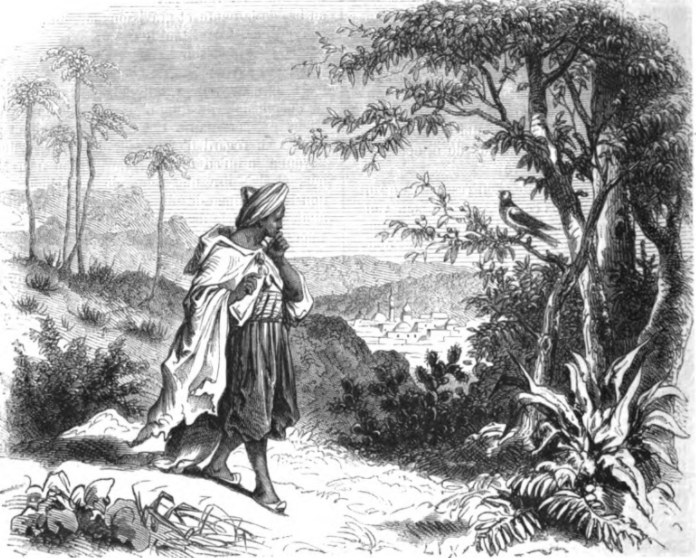
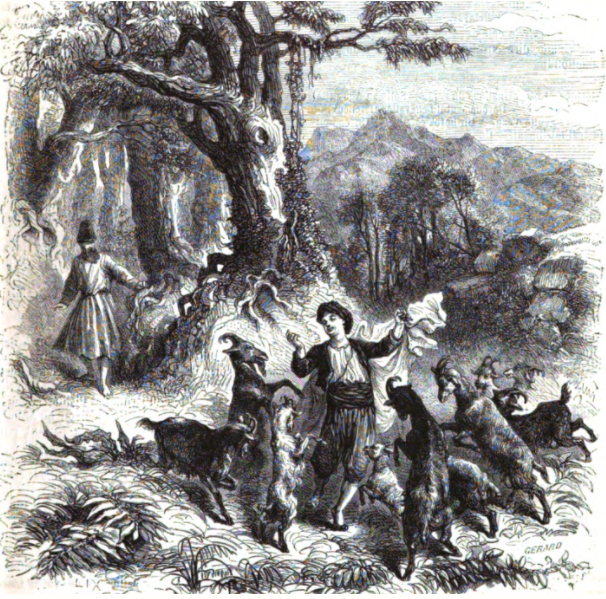
ここには山羊飼いカルディの伝説において最も有名な挿絵が載っている。この挿絵は「ヤギたちの踊り(La danse des chèvres)」という題であり、描いたのはフレデリック・リックス(Frédéric Lix)である。この挿絵は「ウサブの山のオマール(Omar sur la montagne d'Ousab)」とともに、ウィリアム・H・ユーカース『オール・アバウト・コーヒー』に用いられたため、一躍有名となった。
*ユーカースの『オール・アバウト・コーヒー』では、「ウサブの山のオマール」は「オマールと素晴らしきコーヒーの鳥(OMAR AND THE MARVELOUS COFEE BIRD)」、「ヤギたちの踊り」は「カルディと踊るヤギたち(KALDI AND HIS DANCING GOATS)」という題で紹介され、作者は「ある現代のフランス人アーティスト(a modern French artist)」となっている。また、山内 秀文訳『ALL ABOUT COFFEE コーヒーのすべて』 では、作者が「フランス人画家、ジェラール画」となっている。この「ジェラール」という名前が誰を指すのかは不明だが、おそらく誤りである。
ちなみに、旦部 幸博『珈琲の世界史』では、「世間に出回っているコーヒーの本を読むと、コーヒーとヒトとの出会いについては、次の2つのエピソードが書かれています」として、「ヤギ飼いカルディ」発見説と「シェーク・オマール」発見説が紹介されているが(24から26ページ)、このような話の構成の仕方のオリジナルがフュルベール=デュモンテイユ『家庭博物館』第三十三巻 「テーブルの自然史。コーヒーの逸話のモノグラフィー。」である。
『家にいる動物たち(Les Animaux chez eux)』「ヤギ(LA CHÉVRE)」
フュルベール=デュモンテイユは、この「ヤギたちの踊り」の逸話を、様々な場所で何度も紹介している。
フュルベール=デュモンテイユが、1882年にパリの出版者であり画家でもあったルドビク・バシェット( L. Baschet, Ludovic Baschet, 1834 - 1909)から出版されたオーギュスト・アンドレ・ランソン(Auguste André Lançon, 1836 - 1887)の挿絵集『家にいる動物たち(Les Animaux chez eux)』の「ヤギ(LA CHÉVRE)」の項目のために書いた文章に、「ヤギたちの踊り」の逸話が登場する。
N'oublions pas que la Chèvre a trouvé le café.
Un jeune berger appelé Kaldi s'aperçut, un jour, qu'après s'être repues avec délices de certains fruits inconnus, ses Chèvres se livraient aussitôt à des cabrioles extravagantes.
Kaldi s'empressa de goûter aux fruits merveilleux et partagea incontinent la gaieté de son troupeau.
Au même instant un moine vint à passer, qui se trouva bien surpris de tomber en plein bal. Une trentaine de Chèvres exécutaient un cotillon fantastique tandis que le bouc, droit sur ses pattes et les cornes inclinées, décrivait gravement un cavalier seul, en face du berger qui figurait une espèce de chaîne des dames.
Le bon moine s'informe du motif de cette fureur chorégraphique, et Kaldi lui raconte sa découverte.
La piété n'exclut pas les instincts gastronomiques. Ceux du moine étaient grands : il imagina de faire bouillir les fruits du berger et cette décoction ingénieuse donna le café.
Le café et le cachemire, la plus riche des étoffes et la plus exquise des boissons, n'est-ce pas assez pour faire pardonner à la Chèvre ses caprices, sa gourmandise et ses moeurs légères !
Auguste André Lançon(1882)"Les Animaux chez eux"p.42-43
『動物画(Portraits zoologiques)』第十二章「ヤギたち(LES CHÉVRES)」
また、フュルベール=デュモンテイユの1874年の著作『動物画(Portraits zoologiques)』の第十二章「ヤギたち(LES CHÉVRES)」では、異なった文章で「ヤギたちの踊り」の逸話が紹介されている。
Il y aurait de l'ingratitude à oublier que la Chèvre a trouvé le café.
Un jeune berger appelé Kaldi s'aperçut un jour que ses Chèvres se livraient aussitôt à des cabrioles extravagantes.
Le Bouc lui-même, le vénérable Bouc, si digne et si sérieux d'ordinaire, bondissait comme un jeune cabri.
Kaldi attribua cette gaieté folle à certains fruits dont ses Chèvre semblait se repaitre avec délices.
Il parait que le berger avait des peines de cœur, et que, dans l'espoir de se distraire un peu, il goûta à ces fruits merveilleux. La chose lui réussit à merveilleux ; Il oublia ses maux, et devint le plus joyeux jeune de l'Arabie Heureuse.
Quand ses Chèvres entraient en danse. il se mettait gaiement de la partie et leur faisait vis-à-vis avec un entrain admirable, ponctuant de sa houlette les pas excentriques d'un menuet oriental.
Un jour, un moine vint à passer, qui demeura bien surpris de se trouver en plain bal. Une trentaine de Chèvres exécutaient avec force cabrioles un cotillon fantastique , tandis que le Bouc , droit sur ses pattes, la barbiche flottante et la corne inclinée, décrivait gravement un cavalier seul en face du berger qui figurait une espèce de chaîne des dames.
Stupéfait , le moine s'informe du motif de cette fureur chorégraphique , et Kaldi lui raconte sa précieuse découverte .
Or , ce saint homme de moine avait un grand souci : il s'endormait toujours au milieu de ses prières , et Mahomet , sans le moindre doute , lui révélait ces fruits excitants pour vaincre son sommeil .
La piété n'exclut pas les instincts gastronomiques . Ceux de notre moine n'étaient pas ordinaires ; il fit sécher , bouillir les fruits du berger , et cette ingénieuse décoction donna le café .
Bientôt tous les moines du royaume firent usage de ce délicieux breuvage , parce que , disaient - ils , il excitait à la prière.
Le cachemire et le café , la plus riche des étoffes et la plus exquise des boissons , une parure et une friandise , un éclat et un parfum n'y a - t - il pas de quoi faire pardonner à la Chèvre ses caprices et ses mœurs légères ?
Jean Camille Fulbert-Dumonteil(1874)"Portraits zoologiques"p.65-67
ちなみに『動物画』では、このような挿絵が用いられている。
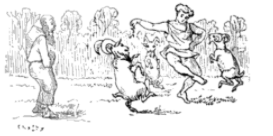
フュルベール=デュモンテイユと「ヤギたちの踊り」
フュルベール=デュモンテイユの「ヤギたちの踊り」は、これまで紹介されてきたファウスト・ナイロニの説話とは、明らかに異なっている。フュルベール=デュモンテイユの「ヤギたちの踊り」は、おそらくファウスト・ナイロニの説話、あるいはその写しにヒントを得たフュルベール=デュモンテイユの創作であろう。そして、これは現在に伝わる山羊飼いカルディの伝説のオリジナルである。彼は面白おかしく話を作り上げるストーリーテラーとしての才能に秀でており、子供向けの雑誌において、彼はコーヒーの逸話を題材にその才能を自由に発揮したのだろう。
なぜ彼はこの逸話に、あるいはヤギに拘ったのか。
J'ai été élevé par une Chèvre et je lui dois, sans doute, cette vivacité capricieuse qui ne m'a guère servi dans ma carrière.
Auguste André Lançon(1882)"Les Animaux chez eux"p.48
フュルベール=デュモンテイユはヤギによって育てられたと述べるほどに、ヤギは彼の幼少期の思い出と結びついていた。そして、カルディが木の実によって元気を得たように、フュルベール=デュモンテイユもヤギのおかげでその生涯を生き生きとしたものにすることができた。そのため、この「ヤギたちの踊り」の逸話は、彼自身にとっても様々に示唆的だったのかもしれない。
そして、フュルベール=デュモンテイユの「ヤギたちの踊り」は、作者自身が作品の背後に消え、作品だけが伝説として流布するという近代稀に見る成功を収めた文学作品と言えるだろう。
ウィリアム・H・ユーカース(William H. Ukers)『オール・アバウト・コーヒー(ALL ABOUT COFFEE) 』
ウィリアム・H・ユーカース(William H. Ukers, 1873 - 1945)は、その大著『オール・アバウト・コーヒー(ALL ABOUT COFFEE) 』で、山羊飼いカルディの伝説を以下のように紹介している。
フランスに伝わっているこの伝説のヴァージョンに次のようなものがある。
「カルディという山羊飼の若者が、ある日、おとなしかった山羊たちが、まるで子供のように夢中になって跳び回っているのを目にした。カルディはこのばか騒ぎは、山羊たちが喜んで食べていた木の実のせいだと気づいた。折しもその若者の気持ちは沈みがちで、少しでも気が晴れるならと、その実を摘んで食べてみることにした。それはすばらしい効き目だった。彼はそれまでの悩みなどすっかり忘れて『幸福のアラビア』(アラビア半島南部のこと)で最も幸福な山羊飼になった。山羊が踊ると彼もその輪に加わり、天にも昇る心地で踊り回った。
ある日、一人の僧が通りかかり、山羊たちが踊るように跳ね回っているのを目にして、驚いて足を止め、そのわけを尋ねた。カルディは彼の見つけた貴重な木の実のことを話した。この僧には大きな悩みがあった。いつも礼拝の最中に眠り込んでしまうのである。この話を聞き、僧は、これは間違いなくマホメットが自分の眠気を払うためにこの驚くべき木の実を授けてくれたのだ、と解釈した。
信仰心は、美味しさを求める妨げにはならない。この僧は山羊飼の食べ方に工夫を加え、実を乾燥させて煮てみることを思いついた。こうして作られた飲み物が、われわれの知るコーヒーである。そしてこの飲み物は、瞬く間にその国の僧たちの間に広がった。それは夜の礼拝の助けになり、その上、不快な味でもなかったからである」。
ウィリアム・H・ユーカーズ(2017)『ALL ABOUT COFFEE コーヒーのすべて』,山内 秀文訳・解説,角川ソフィア文庫.p.37-38
この原文は以下のとおりである。
The French have preserved the following picturesque version of this legend :
A young goatherd named Kaldi noticed one day that his goats, whose deportment up to that time had been irreproachable, were abandoning themselves to the most extravagant prancings. The venerable buck, ordinarily so dignified and solemn, bounded about like a young kid. Kaldi attributed this foolish gaiety to certain fruits of which the goats had been eating with delight.
William H. Ukers(1935)"ALL ABOUT COFFEE",Second Edition.p.10-11
The story goes that the poor fellow had a heavy heart; and in the hope of cheering himself up a little, he thought he would pick and eat of the fruit. The experiment succeeded marvelously. He forgot his troubles and became the happiest herder in happy Arabia. When the goats danced, he gaily made himself one of the party, and entered into their fun with admirable spirit.
One day, a monk chanced to pass by and stopped in surprise to find a ball going on. A score of goats were executing lively pirouettes like a ladies' chain, while the buck solemnly balancé-ed, and the herder went through the figures of an eccentric pastoral dance.
The astonished monk inquired the cause of this saltatorial madness ; and Kaldi told him of his precious discovery.
Now, this poor monk had a great sorrow ; he always went to sleep in the middle of his prayers; and he reasoned that Mohanmed without doubt was revealing this marvelous fruit to him to overcome his sleepiness.
Piety does not exclude gastronomic instincts. Those of our good monk were more than ordinary ; because he thought of drying and boiling the fruit of the herder. This ingenious concoction gave us coffee. Immediately all the monks of the realm made use of the drink, because It encouraged them to pray and, perhaps, also because it was not disagreeable.
この「フランスに伝わっているこの伝説のヴァージョン」は、明らかにフュルベール=デュモンテイユの「ヤギたちの踊り」を参考にしている。例えば、「信仰心は、美味しさを求める妨げにはならない(Piety does not exclude gastronomic instincts)」という表現は、La piété n'exclut pas les instincts gastronomiquesの英語訳である。
しかし、ユーカースの「フランスに伝わっているこの伝説のヴァージョンに次のようなものがある(The French have preserved the following picturesque version of this legend )」という前置きは、誤解の原因となった。彼はこれが創作であると記述すべきだったのである。
最も有名コーヒー本と言っていい『オール・アバウト・コーヒー』によって、フュルベール=デュモンテイユの「ヤギたちの踊り」は「山羊飼いカルディの伝説」として人々の間で広く共有され、コーヒーの起源の伝説としてその人気を不動のものとしたのである。
ファウスト・ナイロニの説話はいかにして山羊飼いカルディの伝説へと姿を変えたのか
これまでの話を整理しよう。
ファウスト・ナイロニの紹介した説話の特徴は、以下のようなものだった。
- ラクダ、またはヤギの世話をする人物が、彼の家畜の一晩中跳ね回り踊っていることを修道院の宗教者たちに不満を述べた
- 場所はアヤマン王国(幸福のアラビア)
- 修道院長が修道士の一人と一緒に、夜にラクダ、またはヤギを見張っていると、果実または、彼らが噛んだ果肉のある低木または茂みを見つかった。
- 彼らは水を沸騰させ飲んでみると、夜通し目覚め続け、夜の義務を務めることができることを発見した。
- この飲み物は王国全体や他の国々や地方、そして東方にまで広がった。
対して、山羊飼いカルディの伝説の特徴は以下のようなものである。
- 木の実(コーヒー)を発見したのは山羊飼い、あるいは山羊飼いが世話をしていたヤギである。
- 木の実を食べたヤギ、あるいは山羊飼いは、元気になり踊り回った。
- 山羊飼いの名前はカルディである。
- カルディは、西暦850年頃アビシニア(エチオピア)に住んでいた。
- カルディは修道院長にコーヒーを紹介した。
- 修道士(または修道僧)たちが木の実の煮出し汁を飲むと、頭がすっきりし、夜通し夜の礼拝を続けられるようになった。
ファウスト・ナイロニの説話はいかにして山羊飼いカルディの伝説へと姿を変えたのかという問いに対して、以下のような解答を与えることができる。
- 「山羊飼いカルディの伝説」はフュルベール=デュモンテイユの「ヤギたちの踊り」という創作がオリジナルであり、そこに尾鰭が付いたものが現在伝わる様々なヴァージョンである。
- 「山羊飼いカルディの伝説」を一般に広く広めたのは、ウィリアム・H・ユーカース『オール・アバウト・コーヒー』である。
- 『オール・アバウト・コーヒー』に用いられている有名な挿絵の画家は、フレデリック・リックスである。
- 西暦850年頃という設定は、アル・ラーズィーの生年から脚色された。
- アラビカ種コーヒーの起源がエチオピアであるということが知られるにつれ、エチオピア起源のコーヒーの物語が必要とされた。そこに「山羊飼いカルディの伝説」はちょうど都合がよかった。
- 「ラクダ、またはヤギ」が「ヤギ」のみに限定されたのは、トーマス・ポープ・ブラント卿の『博物学』が最初である。
ここでファウスト・ナイロニの説話がいかにして山羊飼いカルディの伝説へと姿を変えたかについての解答を得ることができた。
最後に1710年に英訳されたアントニウス・ファウスト・ナイロニ(ANTONIUS FAUSTUS NAIROBUS)『コーヒー論(A Discourse on Coffee)』の、山羊飼いカルディの伝説に関連する部分を以下に訳出する。
アントニウス・ファウスト・ナイロニ(ANTONIUS FAUSTUS NAIROBUS)『コーヒー論(A Discourse on Coffee)』
Give me Leave to tell you, that the drinking the Liquor call'd Cahuê or Café was much a Proof of fortuitous Experience as the former Cafe, as the Narrative following will make appear.
読者に伝えることが許されるなら、「カウエ」や「カフェ」と呼ばれるリキュールを飲むことは、コーヒー以前のように思いがけない経験の証であって、物語では次のように現れるだろう。
A certain Person that look'd after Camel, or, as others report it, Goats,(this is the common Tradition amongst the Eastern People) complain'd to the Religious of a certain Monastery in the Kingdom of Ayaman, that is Arabia Felix, that his Herds twice or thrice a Week , not only kept awake all Night long, but spent it in frisking and dancing in an unusual Manner.
ラクダ、または、他の人々の報告では、ヤギ、(これはオリエントの人々の間では一般的な伝承である)を世話するある人物が、彼の家畜の群が週に二回または三回、一晩中目を覚ましているだけでなく、それを異常な方法で跳び回り踊りにそれを(一晩中)を費やしていることを、「アヤマン」王国、それは幸福のアラビア、のある修道院の宗教者たちに不満を述べた。
*当時ヨーロッパにおけるオリエントは、アジアではなく現在の中東のことを指した。
The Prior of the Monastery, led by his Curiosity, and weighing the Matter, believ'd this must happen from the Food of these Creatures : Marking, therefore, diligently, that very Night, in Company with one of his Monks, the very Place where the Goats or Camels pastur'd, when they danc'd, found there certain Shrubs or Bushes, on the Fruit or rather Berries of which they fed.
修道院長は、好奇心に導かれ、関心事を推し量り、これはこれらの生物の食物から起こるに違いないと信じた:したがって、彼の修道士の一人と一緒に、一生懸命に、見張っている、まさにその夜、ヤギまたはラクダが踊ったとき、彼らが放牧されたまさにその場所で、果実またはむしろ彼らが噛んだ果肉のある、ある低木または茂みを見つかった。
He resolv'd to try the Vertues of these Berries himself ; thereupon, boiling them in Water, and drinking thereof, he found by Experience, it kept him awake in the Night.
彼はこれらの果肉の美徳を自分で試すことを決心した ; そこですぐに、それらを水で沸騰させ、それを飲むと、それは彼を夜の間目覚めさせ続けたことを、彼は経験によって見つけた。
Hence it happen'd that enjoin'd his Monastery the daily Use of it, for this procuring Watchfulness made them more readily and surely attend their Devotions which they were obliged to perform in the Night.
したがって彼の修道院に毎日の使用を命じたことが起こった。なぜなら、この注意深さを獲得することは、彼らが夜に実践する義務があった彼らの献身により簡単にそして確実に参加させるからである。
When, by this frequent Use of it, they daily experienced its Wholsomness, and how effectually it conduc'd to the preserving them in perfect Health, the Drink grew in Request throughout the whole Kingdom, and in Progress of time, other Nations and Provinces of time, other Nations and Provinces of the East fell into the Use of it.
その時、それのこの頻繁な使用によって、彼らは日々その有益さと、それが彼らが完全な健康を保つことを助けるのにどれほど効果的であるかを経験し、この飲み物は王国全体で、そして時間の経過とともに、当時の他の国々や地方で、その使用に陥った「東」の他の国々や地方で、需要が増した。
Thus by a meer Accident, and the great and wonderful Province of the Almighty, the Fame of its Wholsomness spread itself more and more, even to the Western Parts, more especially those of Europe.
このように、単なる偶発的な出来事と、偉大で素晴らしい全能の地方によって、その有益さの名声は、「西」の地域、特に「ヨーロッパ」の地域にさえも、ますます広がった。


